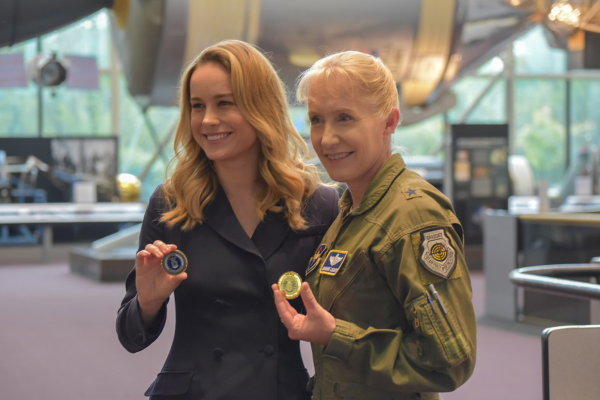Brie Larson meets with former female pilot at the National Air and Space Museum. (Wikimedia Commons)
Captain Marvel, the latest installment in the Marvel Cinematic Universe (MCU), premiered Friday, March 8th, and quickly rocketed to a record-breaking $455 million international opening weekend.
The origin story about Carol Danvers (Brie Larson), a pilot turned Kree supersoldier (aka Captain Marvel), is Marvel’s first superhero movie with a female lead and comes just a month before the highly anticipated release of Avengers: Endgame.
Centered around Danvers and Nick Fury (Samuel L. Jackson) working together to defend earth, many have drawn the resemblance between Captain Marvel and a buddy-cop flick due in part to Larson and Jackson’s chemistry.
Larson’s performance was quite good, yet Jackson’s performance was impeccable as always.
Ben Mendelson does a great job in the role of Talos, the main Skrull Villain, and Jude Law works well as Danver’s Kree mentor, Yon-Rogg.
Other stars completed the cast with Gemma Chan as Kree sniper Minn-Erva, Clark Gregg returning as Agent Coulson, Lashanna Lynch as Danver’s best friend Maria Rambeau, and Goose the cat, who was an absolute show-stealer.
The overall pacing of the movie was fine, as the film did a good job of never getting too boring. The first act, which took place in space, was lackluster compared to the other two acts on Earth, notably missing Jackson’s Nick Fury.
The plot was decent but contained nothing as particularly memorable as other Marvel movies have, and the soundtrack was nothing special.
The weakest point in the movie, however, was the action. Whether it was the shaky camera work, subpar editing, or simply weak choreography and writing, the action scenes are unimpressive. Carol Danvers was described as an ace pilot, but dogfights were devoid of any major thrill that one might find in the decades-old Top Gun.
Captain Marvel didn’t launch without controversy either. Larson’s past comments on diversifying the press pool due to its heavy majority of white males outraged some, who conspired to ‘review-bomb’ the movie.
This meant that barely after its release, thousands of trolls took to review sites like Rotten Tomatoes to slam the movie without even seeing it first. In these reviews is where Larson was lambasted as ‘emotionless,’ a ‘toxic SJW,’ and a ‘Captain Mary Sue.’
Larson’s performance wasn’t perfect, but it certainly proved the trolls wrong. Captain Marvel didn’t possess the ‘feminist propaganda’ that some would like to claim. Its nods to feminism were subtle but not forced. Larson and Lynch’s on-screen friendship was a refreshing change of pace for an industry where the most common thing women talk about are their husbands.
Captain Marvel was fun and enjoyable, a story about getting up when you’re knocked down and succeeding when you’re told that you’re not good enough. That’s a message that can appeal to everyone, no matter their gender.
If Captain Marvel as a character can be fleshed out further in future movies, like with Thor’s improvement from The Dark World to Ragnarok, Carol Danvers could become a household name like Tony Stark.
As a simple superhero movie, it’s good but not great. Culturally, however, it follows the lead of Gal Gadot’s Wonder Women in paving the way forward for greater equality in the filmmaking industry and represents the first of a hopefully growing genre of female superhero movies.








